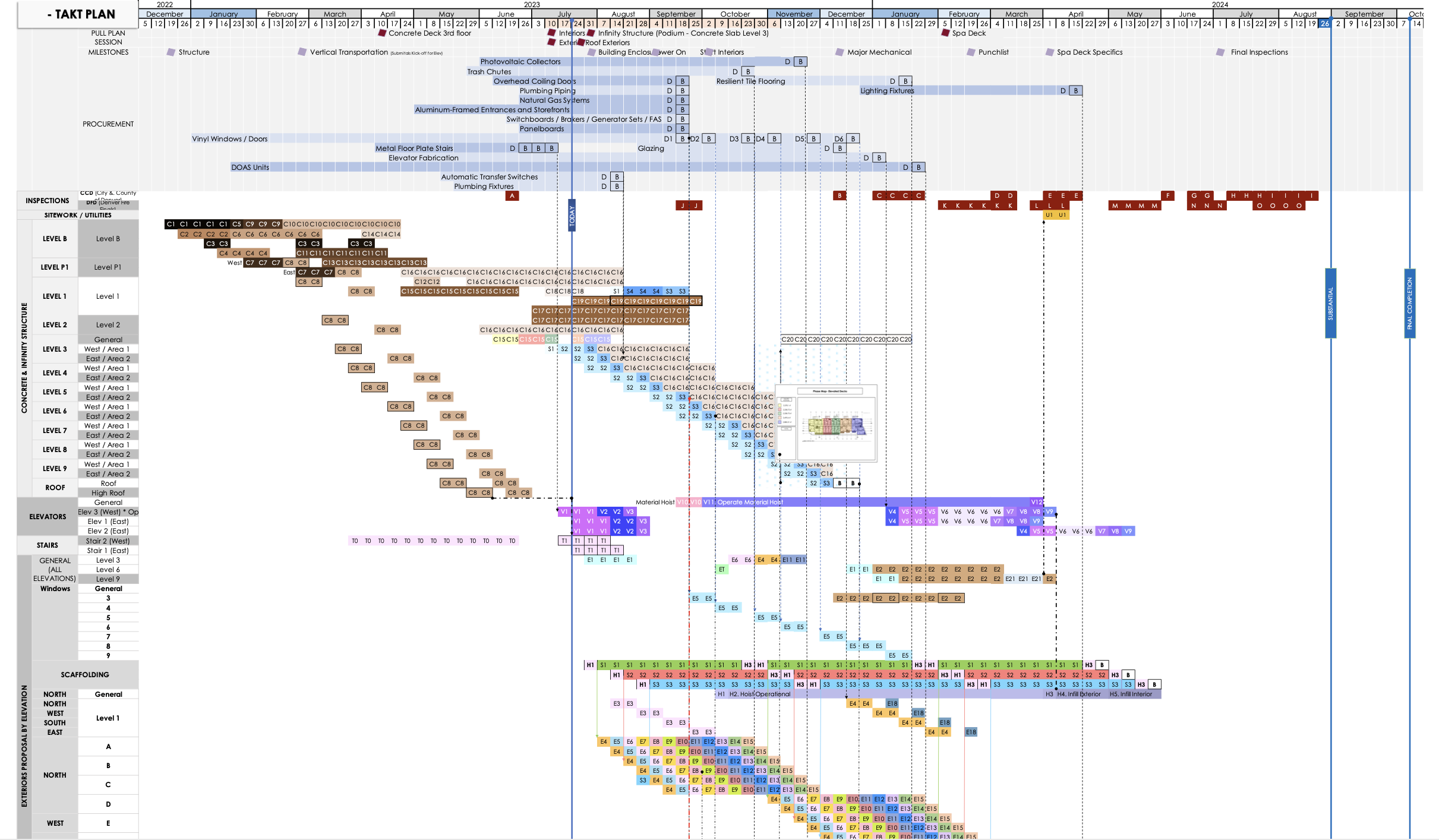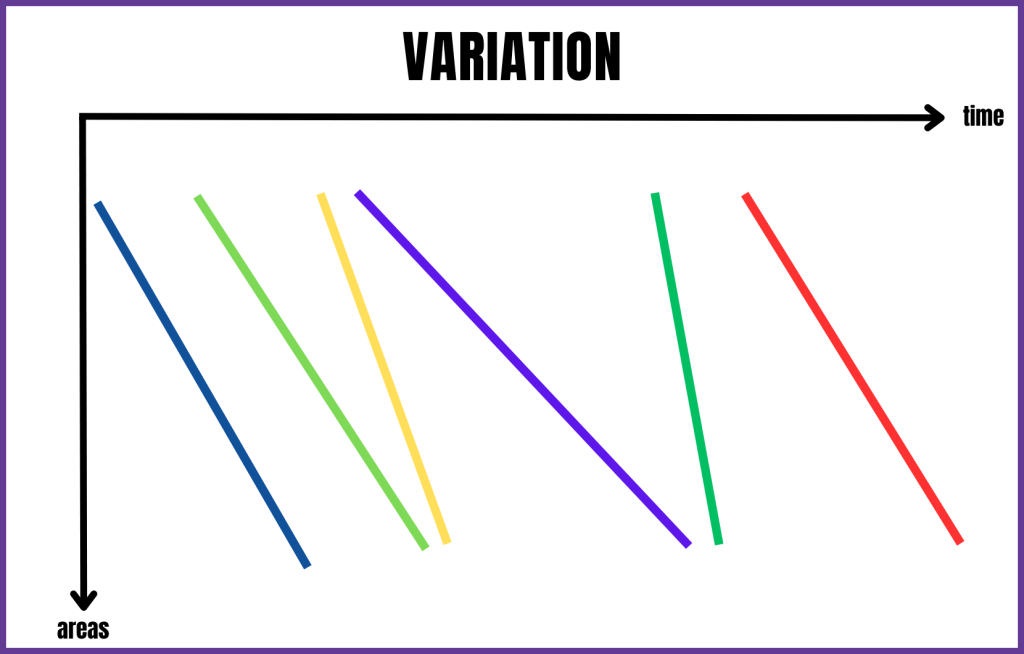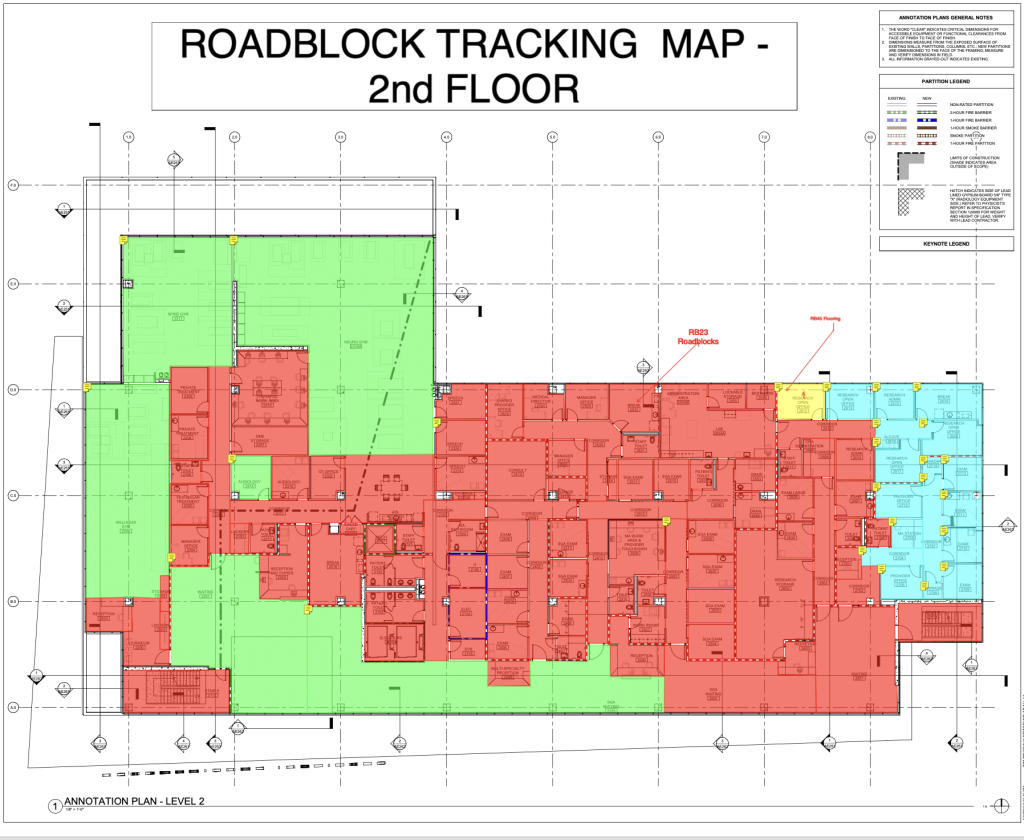Takt Planning is a detailed one-page, one-process flow schedule that focuses on throughput, production, bottlenecks, and ultimately, creating flow. It is accompanied by Lean practices to be the most effective scheduling tool in the industry for construction because it creates stable construction environments, enables total participation, and provides a basis upon which to improve all aspects of construction.
In German, the word Takt means beat frequency or the regularity with which something gets done. When used with Lean, it means standardization, predictability, and the heartbeat of the project’s production system. Our definition of lean and how it applies to construction is simple and important to define as there has not been a standard until now on what Lean is. We take a similar approach to Niklas Modig in his Book This is Lean, but in this Blog Post, we will give our basic definition and links where you can learn more.
Lean Definition:
Respect for People and Resources
Stability and Flow
Total Participation & Visual Systems
Continuous Improvement & Quality
Jason Schroeder dives deep into these theories and how you and your project team or company as a whole can assess where you are at and helps facilitate that change in his Online Course “The Foundation of Construction Excellence” on the Construction Excellence platform that is part of the Operational Excellence group.

Click this video to see what this course is and how lean principles are actually used to achieve success in construction.
Now we understand the basics of the principles that when applied with Takt make all the difference. So let’s dive into the Takt theory side of the equation and for that we start with the basic definitions.
Takt Definitions:
Takt: German for baton, beat, or rhythm
Takt in Takt Planning: The individual cell representing the intersection of time and space. This can be empty or include a Takt wagon. It is the basic unit of a Takt plan.
Takt Plan: The strategic and logistical visual plan that shows the Takt trains in relationship to each other per the specified Takt time with columns of time and rows of Takt zones (geographical location) or general sequences.
Takt Control: A tactical system of holding the dates, stabilizing procurement, limiting work in process, and finishing as you go. It is the process of using the execution plan within the Takt plan that is constantly evolving and making short-cycled adjustments of the Takt plan to increase flow and improve the execution of the work. Typically, Takt planning takes 20% of the time in development, and the remaining 80% is spent in Takt control.
Takt Phase: The grouping of Takt trains by zones that compile to make up similar types of scope, e.g., structural, rough-in, and exteriors. Takt time and throughput time are specific to Takt phases.
Takt Zone: A production area that is determined by its repeatability and ability to fit into a rhythm with other areas to balance the overall production schedule. This is a batch of geographical area that is either increased or decreased to achieve flow.
Takt Train: A series of wagons in a Takt zone. This is also sometimes called a Takt sequence.
Takt Wagons: One or more work packages or scope(s) of work packaged into a single cell in a Takt train usually shown on Excel, or a Takt when in an application like Takt.ing.
Work Packages: Features of work or scopes within a Takt wagon. If found within the same Takt wagon, they should not constrain or hinder each other in any way.
Work Steps: The tasks in the installation process within the work package. For example, if your work package was OH Electrical, then the steps might be conduit runs, light boxes, fire alarm, cable tray, low voltage, etc.
Takt Time: Measurable beat time, rate time, or heartbeat. In Lean, Takt time is the rate at which a finished product needs to be completed in order to meet customer demand. It is the syncopation or rate of beats such as one might find on a metronome. To expound, Takt time is the duration of the time scale into which the Takt wagons are fit. If the Takt time is five days, the wagons fit into multiples of that duration. If a wagon includes the work package of overhead mechanical and that overall duration is fifteen days, and the Takt time is five days, there will be three Takt wagons that say, “Overhead Mechanical” in three-time scales.

Where does Takt come from?
Takt time is taken from the German word Taktzeit, meaning cycle time. According to Colin Ducharme and Todd Ruddick, who teach Lean Six Sigma courses, “The word was likely introduced to Japan by German engineers in the 1930s,” which explains why Lean and Takt have an interwoven history.
The actual word originates from the Latin word tactus meaning touch, sense of touch, feeling. Some earlier meanings include beat triggered by regular contact, clock beat from the 16th century, beat indicating the rhythm pertaining to music, and also regular unit of note value from the 18th century.
Takt is focused on the rhythm of sequences or geographical areas on the project site sometimes known as location-based scheduling. European countries have successfully been using this type of scheduling for years. Early Takt plans have been found from Norway with ship building. Also, in Russia and Germany over a century ago with a very detailed and sometimes complex mathematical analysis. Takt planning has been called a variety of names over the years: One-Process Flow Scheduling, Linear Scheduling, SIPS, Line of Balance, or Even Flow Production. It feels appropriate to call it by the name of Takt because it has a good brand name throughout the industry currently and allows us all to rally behind the concept together.
Takt planning can be seen in the construction of the Empire State Building
and more recently in the United States Pentagon Renovation constructed by Hensel Phelps in 2002. This planning was termed SIPS or Short Interval Planning Schedule which is what we have termed above a Takt phase and are very similar in execution.

Despite both of these projects being wildly successful, CPM continues to be the dominant scheduling system in the United States.The argument for CPM is typically the favoring of data and data mining; however, visual schedules and uniting the workforce around a common plan should be more important. Additionally, Takt is not only rich with data, it is also the only scheduling system based on mathematical production equations and production laws.

Batching vs. OPF
The biggest difference between CPM and Takt is one-process-flow vs. batching. One-process flow describes a condition where work is finished one scope or process at a time from beginning to end, instead of in large batches. Processes or work moves from phase to phase or step to step in a flow on the shortest path possible on its way to the customer. Examples of one-process flow are as follows: Sending out meeting minutes right after the meeting, filling out an inspection report right after the visit, answering emails as they arrive, finishing work areas by scope while there and work is in progress, excavating, installing, inspecting, and backfilling sections of pipe in segments, and starting, building, and completing phases of work before starting another one. To do this, we need to be open to…

One-piece flow is a concept centered around flow units progressing from inception to the customer on the shortest path possible. All parts are working in unison accepting and passing work to the next trade in line (sequence). It means that we reduce the amount of work in process and we finish one piece of work as we go and move work down the line in smaller amounts as opposed to…
Batching (DON’T DO THIS!)
Batching occurs when product, work, or assemblies are completed in groups to increase the efficiency of resources rather than flow. Batching work in construction looks like doing one scope of work throughout the entire floor or entire building without respect to flow. A good example to show the difference between one-piece flow and batching is the envelope game. In the envelope game two contestants are given twenty envelopes, papers, and stamps.
The first contestant is told to fold all papers at once, stuff the papers at once, lick and seal them at once, and then stamp them at once. The second contestant is told to fold, stuff, lick, seal, and stamp each of them one at a time. Each contestant starts at the same time and is asked to finish as fast as possible. It is nerve wracking to watch this game because the batching contestant looks sure to win, but with two minutes to spare, the one-piece flow contestant finishes first. One-piece flow is faster and always will be because it releases work on a rhythm and allows work to flow.
The batching system is usually preferred because it looks like it goes faster, but that is simply because it is riddled with motion and transportation (picking envelopes up, putting them down, over and over) which is waste. With Takt systems or flow systems, we finish as we go or follow the concept of one-piece flow which means the work is delivered to the customer in the fastest way possible. This creates flow.
Flow:
Flow is a priority for construction. Why? Because flow enables the very long supply chains upon which we rely in construction by holding to consistent dates, and it reduces the material inventory levels and worker counts on a project site at the end of that supply chain by allowing us to bring out materials just-in-time.
This is important because the reduction of material inventory is essentially the reduction of overproduction in construction which then reduces all other wastes! When overproduction and excess material inventory are reduced, the need for fixing defects, over processing, waiting, transportation, and motion are reduced because we are using the genius and capabilities of the team, maintaining a consistent schedule and flow one-process or one Takt-ed process at a time.
The effects that waste, variation, and roadblocks have on production in the field are widely recognized and accepted, and at a minimum, they culminate in wait times and prevent good flow. If we maintain flow, prepare our work, stabilize our supply chains, and hold our dates according to a good Takt time, we will have a good flow of information, worker counts, and materials because the dates, rhythm, targets, and expectations all remain consistent, steady, and continuous, just like when water flows.
Holding the line
Just-in-time deliveries really only work with Takt planning and really only work when project teams hold to the rules of Takt by holding the dates. Now, there are some exceptions to this rule. If there is a major shift needed for project success that can be coordinated with all participating contractors onsite and that can be coordinated with procurement, then this type of change may be acceptable.
But for the most part, gaining time in Takt planning is done in the plan analysis where we optimize throughput time and gain buffers by running simulations that determine the ideal project duration based on the number of Takt wagons, Takt zones, and the Takt time. When a project is coming out of the ground, expediting, or advancing the schedule is more appropriate because there are fewer contractors. Therefore, it is more acceptable in the early phases, but only under rare circumstances should dates be moved and start dates be adjusted when there are over ten contractors onsite working in rough-in, exteriors, or finishes.
With Takt systems we need to hold the line, keep the rhythm, and be disciplined, otherwise we leave the system and the project descends into chaos. Therefore, Takt planning requires project teams to hold others accountable, control the site, and hold the line. This is very difficult for a team and can be a reason project teams may be hesitant to use the Takt system. It is also why trades may be hesitant to participate with Takt because they will be held accountable. You can be sure that weak leaders and non-accountable trades will not like Takt. Takt keeps the system stable, and then the team can accelerate when…
Bottlenecks
Some may be very concerned about our comment to slow down certain resources but consider what happens when, after we have optimized and sped up a ll bottlenecks, we continue to let the faster trades continue to go fast. What happens? People are stacked in certain areas without flow, without geographical control, burying certain scopes, and/or installing too early which increases the amount of defects and use of resources such as the project management team’s time. This affects the trades that really need the help. There is little merit to going faster than the general throughput.
The Law of Bottlenecks: According to Modig, the Law of Bottlenecks states that throughput time is primarily affected by the process that has the longest cycle time. In construction, the overall throughput of the phase is mostly affected by the process with the longest duration within the system.


The tricky thing with bottlenecks is that new ones will show up when you optimize the first ones or the largest ones so it is a continual game of increasing flow by adjusting the throughput of the system. This is the key to achieving the shortest overall duration, with the smallest crew sizes, with the most minimal material inventory, in a visual system that identifies problems when they happen, in a continuous flow that allows an evenness the team can use to focus their attention on the removal of roadblocks.
Roadblocks Removal:
Roadblock tracking maps are crucial to the system. They are used to show the differentiation between typical and non-typical areas and also to track roadblocks visually throughout the system. They can be based on the Takt zone maps and can either be physical drawings with plexiglass coverings on your conference room wall or a Bluebeam Project to which everyone has access. The point is to spend most of the time focusing on the removal of roadblocks as the number one standing tactical order. We will soon explain how this is done.
For now, we need to understand that the goal of Takt is to even out the flow by removing roadblocks that become visual. As we remove roadblocks, reduce variation, and increase our visibility and effectiveness, we will understand the true production rate or throughput for this type of work in this geographical area and you can now…

If you want to learn more we have:
-Takt Virtual Training: (Click here)
-Check out our Youtube channel for more info: (Click here)
-Listen to the Elevate Construction podcast: (Click here)
-Check out our training programs and certifications: (Click here)
–The Takt Book: (Click here)
Discover Jason’s Expertise:
Meet Jason Schroeder, the driving force behind Elevate Construction IST. As the company’s owner and principal consultant, he’s dedicated to taking construction to new heights. With a wealth of industry experience, he’s crafted the Field Engineer Boot Camp and Superintendent Boot Camp – intensive training programs engineered to cultivate top-tier leaders capable of steering their teams towards success. Jason’s vision? To expand his training initiatives across the nation, empowering construction firms to soar to unprecedented levels of excellence.
On we go!




